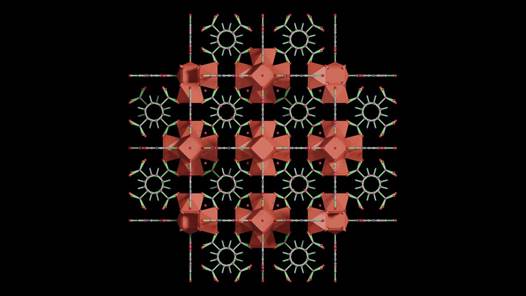Researchers have carried out an in-depth analysis of the mechanisms underlying the flexibility of crystals of Metal-organic frameworks (MOFs) and attributed the flexibility to large structural rearrangements associated with soft and hard vibrations within a crystal that strongly couples to strain fields. The analysis opens doors to innovative materials with diverse applications in various industries.
Metal-organic frameworks (MOFs) are a large class of crystalline materials which possess the remarkable ability to absorb gases, such as carbon dioxide, and store them as well as act as filters for crude oil purification. MOFs derive their ability from the presence of nanopores, enhancing their surface areas that, in turn, make them adept at absorbing and storing gases. However, limited stability and mechanical weakness have hindered their broader applications.
Addressing this issue, Professor Umesh V. Waghmare from the Theoretical Sciences Unit at Jawaharlal Nehru Centre for Advanced Scientific Research, (JNCASR) Bengaluru (an autonomous institution under the Department of Science & Technology, Govt. of India) and his team recently introduced a novel quantitative measure of mechanical flexibility for crystals that can be used to screen materials database to identify next-generation flexible materials.
Their paper, “Quantifying the intrinsic mechanical flexibility of crystalline materials”, presents groundbreaking insights on the origin of mechanical flexibility and was published in the journal Physical Review B. In particular, the focus of Prof. Waghmare’s research lies with MOFs, which are known for their beautiful crystalline structure and large flexibility.
Historically, flexibility in crystals has been assessed in terms of a parameter called elastic modulus, which is a measure of a material’s resistance to strain-induced deformation. In contrast, this study proposes a unique theoretical measure based on the fractional release of elastic stress or strain energy through internal structural rearrangements under symmetry constraints. This new metric can be readily calculated using standard techniques of simulation and can rate the flexibility of a crystal on a scale of zero to one, zero signifying the least flexibility while one indicates maximum flexibility. Additionally, this development provides a unique and quantitative insight into the flexibility of crystals, a dimension that was previously unexplored.
Using theoretical calculations, the team examined the flexibility of four different systems with varying elastic stiffness and chemistries. They discovered that flexibility arises from large structural rearrangements associated with soft and hard vibrations within a crystal that strongly couples to strain fields.
The team’s research thus goes beyond traditional approaches by providing an in-depth understanding of the mechanisms underlying a crystal’s flexibility. Unlike previous studies that primarily focused on elastic properties, this work establishes flexibility as an intrinsic property of crystals, independent of their specific shape or form.
The newfound measure of flexibility is poised to revolutionize materials science, especially in the context of MOFs. Prof. Waghmare emphasizes, “This theoretical framework enables the screening of thousands of materials in databases, providing a cost-effective and efficient way to identify potential candidates for experimental testing. The design of ultraflexible crystals becomes more achievable, offering a practical solution to the challenges posed by traditional experimental methods.”
The collaborative effort underlying this research is particularly noteworthy, with a team of physicists and chemists from Oxford University and the University of California, Santa Barbara involved in the study. This interdisciplinary approach facilitated a more comprehensive understanding of the subject, bridging the gap between theoretical insights and experimental applications.
While the proposed measure of flexibility is theoretical, experimentalists will find it very useful. The potential applications of this research extend beyond the realm of physics, opening doors to innovative materials with diverse applications in various industries.
Paving the way for a new paradigm in materials research, the study exemplifies the significance of interdisciplinary collaboration and theoretical advancements in shaping the future of materials science.

Prof. Waghmare and his team have proposed a novel quantitative measure of flexibility for crystalline materials, specifically metal-organic frameworks.
Image credit: Shutterstock
 Matribhumi Samachar English
Matribhumi Samachar English


